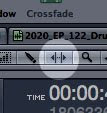
Although the theory behind it was developed back in 1978, time-stretching - the ability to change the length of a sample without effecting the pitch - didn't really appear on much of a practical level for most of us until the late 80's/early 90's. This ability, which most of us take for granted now, totally revolutionized sampling and helped spawn the breakbeat era. Finally, musicians could speed up or slow down a drum loop without the dreaded munchkinization/darth vaderization of their sound. There were obviously practical limits to this technique, and more extreme values led to long, evolving grainy washes. As with many things, at first this was avoided, but as the technology became old hat, people started to exploit this effect, and indeed, it can be a really cool source of otherworldly sounds.
Most audio editors have time stretching/compressing abilities in one form or the other, but I've personally never worked with one as easy as Apple Soundtrack Pro
1. Open up a piece of audio. It can be literally anything, although you will discover the characteristics of the sound you choose has some influence on your final sound. But for now, just load up anything and use the arrow tool to select about a one second snippet. Hit Apple-C to copy your selection to the clipboard.
2. Select File->New->Audio File to create a new, empty file.
3. Soundtrack won't let you stretch beyond the original total file length, so we're going to insert silence to extend the file length of our new file beyond the length of our audio snippet. Select Process->Insert->Silence... and when the dialogue box appears, click and drag your mouse over the time window to increase the length of the inserted silence to about 1 minute.
4. Hit return on your keyboard to return the playhead to the beginning of the file and hit Apple-V to paste your audio selection at the beginning of your new file.
5. You'll probably barely be able to see it because it's so small compared to the total file length, so use the zoom slider at the bottom right hand corner of the window to zoom in. Once you can see the audio easily, use the arrow tool to select just the audio portion (and none, or as little silence as possible). Now zoom back out again so you can see the entire length of the file, but not so far that you can't still see your selected audio.
6. Select the time-stretching tool from the tool bar in the top right hand corner of the window. It's the fourth tool from the left. (I've circled it in the picture at the top of this article). Place the pointer on the right-hand edge of your audio selection and you should see the marquee change to the time-stretching icon. Click and drag to the right. You should see a 'ghost image' of the waveform being stretched until you release it. Soundtrack will only allow you to stretch by a certain percentage at a time, so at a certain point, you won't be able to move the pointer any furhter. Go ahead an let go and wait for the audio to stretch. Now repeat again, dragging the right hand part of the selection as far as it will go to the right. Keep doing this until you've filled the entire minute. Keep in mind the longer you stretch your file, the more calculating the program needs to do, so each time will take slightly longer.
7. Now play back your grainy, alien soundscape by hitting the spacebar.
8. This is pretty cool in itself, but take it to the next level in your DAW of choice and throw some plug-ins on it.... filters, delays, big reverbs... anything that sounds good. Or better yet, throw it in your sampler of choice for further abuse. Before you know it, you have the perfect eerie intro to that track you've been working on. Here's a quick and dirty example:
Note that most DAWs have time-stretching abilities built-in... I just find the way Soundtrack implements it a bit more fun to use, especially for extreme settings.




















3 comments:
awesome tip!
any other unique uses for soundtrack pro? I didn't even install it b/c i didn't se the point but i think i'll have to go back now and give it a shot.
It's hard for me to say, because the last time I used Peak was years ago, so I don't know what Soundtrack offers that Peak doesn't and vice-versa, but for what it's worth, Soundtrack is pretty much my go-to audio editor these days.
Here's a link to Apple's age regarding its features:
http://www.apple.com/logicstudio/soundtrackpro/
This can't succeed in reality, that is what I think.
Post a Comment